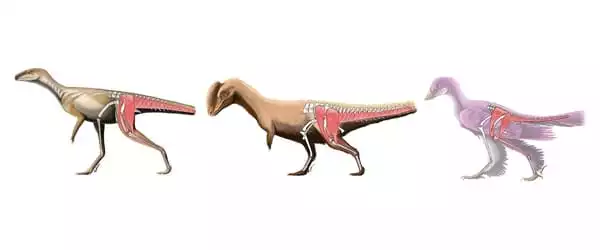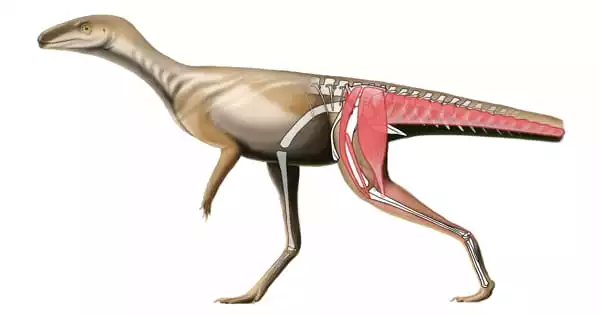A new study led by the University of Bristol has revealed how huge 50-tonne sauropod dinosaurs such as Diplodocus developed from much smaller progenitors such as the wolf-sized Thecodontosaurus. Researchers provide a reconstruction of Thecodontosaurus limb muscles in a new study published in the journal Royal Society Open Science, showing the anatomy of the most critical muscles involved in locomotion.
Thecodontosaurus is a herbivorous primitive sauropodomorph dinosaur genus that existed in the late Triassic epoch (Rhaetian age). Its skeletons are largely known from Triassic “fissure fillings” in South England. Thecodontosaurus was a small bipedal animal that measured around 2 m (6.5 ft) in length. It was one of the first dinosaurs unearthed and one of the oldest that ever lived. Many species have been named in the genus, but only Thecodontosaurus antiquus is considered legitimate now.
Thecodontosaurus was a small to medium-sized two-legged dinosaur that lived during the Triassic epoch in what is now the United Kingdom (around 205 million years ago). Although this dinosaur was one of the first to be identified and named by scientists in 1836, it continues to surprise scientists with new facts about how the early dinosaurs lived and evolved.
These kinds of muscle reconstructions are critical for understanding functioning aspects of extinct organisms’ lives. We may utilize this information to employ computer methods to replicate how these creatures walked and ran.
Professor Emily Rayfield
Antonio Ballell, a PhD student at Bristol’s School of Earth Sciences and the study’s principal author, stated: “The University of Bristol has a large collection of excellently preserved Thecodontosaurus fossils discovered in the Bristol area. The fascinating thing about these fossilized bones is that many of them still have scars and rugosities from the limb musculature’s connection.”
These characteristics are particularly useful in scientific terms for determining the shape and direction of the limb muscles. Reconstructing muscles in prehistoric species necessitates not just extraordinary fossil preservation, but also a thorough grasp of the muscular anatomy of current, closely related species.
Antonio Ballell also stated: “In the case of dinosaurs, we must consider current crocodilians and birds, which comprise a group known as archosaurs, which means “ruling reptiles.” Dinosaurs are extinct members of this family, and because of their evolutionary similarities, we can compare the muscular structure of crocodiles and birds and study the scars they leave on bones to identify and rebuild the position of those muscles in dinosaurs.”

Professor Emily Rayfield, the study’s co-author, stated: “These kinds of muscle reconstructions are critical for understanding functioning aspects of extinct organisms’ lives. We may utilize this information to employ computer methods to replicate how these creatures walked and ran.”
The authors conclude that Thecodontosaurus was highly nimble and probably used its forelimbs to grip objects rather than walking based on the size and orientation of its limb muscles. This is in contrast to its later relatives, the giant sauropods, which acquired their enormous body sizes in part by moving to a quadrupedal stance. Thecodontosaurus’ muscular anatomy appears to imply that crucial traits of subsequent sauropod-line dinosaurs had already evolved in this early species.
Except for the front of the skull, most of Thecodontosaurus’s skeleton can be rebuilt from fragmentary fragments. Thecodontosaurus had a short neck that supported a big cranium with enormous eyes. It has several small to medium-sized, serrated, leaf-shaped teeth in its jaws. The hands and feet of this dinosaur each had five digits, and the hands were long and thin, with an extended claw on each. The front limbs of this dinosaur were significantly shorter than the legs, and its tail was far longer than the head, neck, and body combined. It was 1.2 metres (3.9 feet) long on average, 30 centimetres (12 inches) or 1 foot tall, and weighed 11 kilograms. The tallest individuals were reported to be 2.5 metres long (8.2 ft).
Another co-author, Professor Mike Benton, stated, “From an evolutionary standpoint, our study adds additional pieces to the jigsaw of how movement and posture altered over the evolution of dinosaurs and in the line to the huge sauropods.”
“How did limb muscles change as multi-ton quadrupeds evolved from tiny bipeds?” The reconstruction of Thecodontosaurus limb muscles provides new information on the early phases of that critical evolutionary transition.” The Natural Environment Research Council financed this study (NERC).





